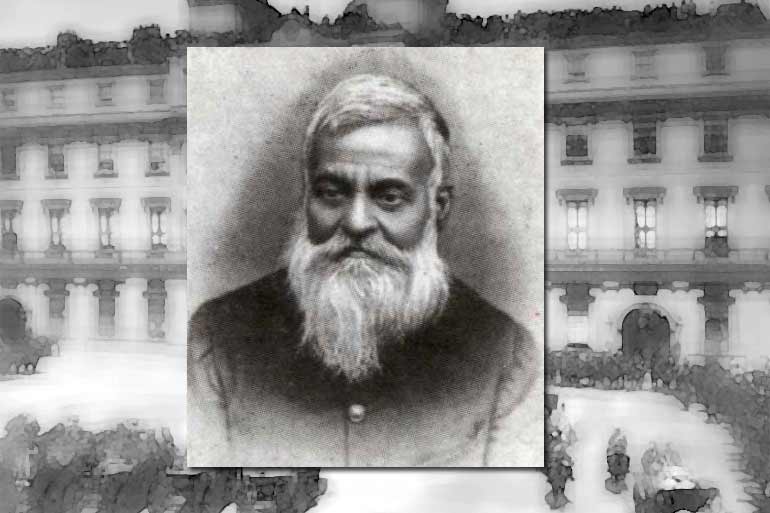Trailokyanath Mukherjee was born on July 22, 1848. In the history of Bengali literature, he is especially known as the creator of satire. Apart from his mother tongue Bengali, he was proficient in several languages like Persian, Oriya etc. Among his books are Kankaboti, Bhoot O Manush, Fokla Digambar, Damrucharita etc.We will discuss about the forgotten Kankaboti.
Trailokyanath Mukherjee’s first novel — the novel can be read by intellectuals — was published in 1892, when he became a mature man, aged 45; At that time the novel created a wave of bizarre juices in the readership.
The question is how far the limits of human imagination can go, or how long the bizarre can be written indiscriminately. So that Trilokyanath has been surprisingly successful. However, the bizarre story told by Trailokyanath is not uncommon in Bengali society, but so is the style of Bengali storytelling.
That is why Dakshinaranjan Mitra Majumdar’s ‘Thakurmar Jhuli (1908)’ still makes a strong impression on the minds of teenage readers. However, it is difficult to say why ‘Kankaboti’ is becoming a forgotten novel day by day. Although we can easily grasp the magical reality of Gabriel Garcia Marquez, we sit down to search for logic in the case of Kankaboti.
The experience of listening to the story of a Bengali reader begins with a fairy tale, but when you come of age, you may not feel like graduating from that juice, do you? The Palm Wine Drinkard (1952) by Nigerian author Amos Tutuwala (The Palm Wine Drinkard 1952) is the epitome of bizarre — the seed of the story in Lokkani ছি I can accept why Kankabati’s fate was not so auspicious!
After the publication of ‘Kankaboti’, Rabindranath praised it a lot, saying: ‘There is no doubt that we liked this novel in general. The author has very easily evoked our humor and compassion in simple language and unabashedly introduced your imagination.
The story is divided into two parts. The first part is about real events and the second part is about impossible strange juices. It is a work of special ability to write such strange fairy tales well. In the realm of the impossible, where there are no fixed rules and no marked highways, we want the quality to guide the voluntary imagination in a mysterious way.
Because no matter how outwardly inconsistent and strange the subject matter of the composition may be, in order to inculcate juice, it must be bound by the rules of literature. The very nature of the fairy tale, its childish simplicity, its undoubted faithfulness that the writer has been able to preserve, is not a matter of little praise to him. ‘
While reading Rabindranath’s ‘Kankavati’, I remembered an English book called ‘Alice in Wonderland’; ‘She is also the dream of such an impossible, unrealistic, funny girl. But there is no such close conflict between the real and the unreal. ‘ The last sentence of Rabindranath has the qualities of becoming a novel of ‘Kankavati’. That is, the clash of the unreal with the real. We have to diagnose this conflict now.
The novel revolves around the public life of a village called Kusumghati. The resident here is Ramtanu Roy, whom people call Tanu Roy, who is an opportunistic Brahmin. He married his two daughters to two old men out of greed for money, and he considered this work scriptural. As usual, the two daughters returned home as widows.
The one who sits and destroys food is angry. Another son follows his father. The youngest daughter is Kankavati. That birth is incomparable in form. Their neighbor Brahmin Shivchandra Mukherjee is educated. Lives in Calcutta. The author introduces him in this way, ‘He used to read in sorrow and relieve the next sorrow as much as possible.
He gave food to many people and paid for the education of many boys. Such a person does not have money in his hands. Khetu is what is meant by an ideal child. Although many people backed away from their grief, Ramhari came forward to help and took Khetu to Calcutta for education. Khetu is a good student as usual. Snacks save money.
Kankabati’s mother came to accompany her mother. Sometimes leave the girl with him. He took care of Laxmimanta girl.
Another Niranjan poet from Kusumghati. Who is a scribe. He left the students at home and gave them food. The subject has no interest in property. Zamindar Janardhan Chowdhury intended to take away five bighas of his fifty bighas of land. Niranjan burned his land deed in front of the zamindar in a tobacco container and said, ‘Why only five bighas?
From today, my entire Brahmottar land is yours. He who has given life will feed Niranjan. ‘Niranjan accepted the abysmal path of poverty. Her students leave her shelter. Tanu Roy’s dispute with Niranjan is about scripture. He has become an enemy by challenging Tanu Roy’s opportunistic scripture.
Khetu came home on holiday and fell in love with the child Kankavati. Bring books for him. Teaches reading etc. Emotions and love developed between them. So that Khetu’s mother and Kankabati’s mother have indulgence. But Tanu Roy wants to marry Kankabati to old zamindar Janardhan Chowdhury out of greed for money. The wedding day is also right.
In the meantime, the zamindar kept Khetu in solitary confinement for eating ‘ice’ like the masters in Calcutta. In alliance with the zamindar are the gang members of Thangare (murderer), Ghandeshwar (alcoholic) and others.
Kankabati’s body became unbearably burnt as the wedding day was fixed and the grief of losing Khetu was felt. He went in the middle of the river by boat and dived to cover his body. Finding her, river fish, crabs, turtles, i.e. aquatic animals make her the queen.
His palace is a huge mansion. To make the queen’s royal attire, Kakra takes Kankavati to the tailor, with a sack of money behind the tortoise. This is the beginning of Kankabati’s magical journey. During the journey we see Kankabati getting married to a tiger. The tiger that is his farm again, that lives in a wonderful palace at the bottom of the hill.
When he goes out, he becomes a tiger. Kankavati lives with her husband in that palace. Khetu died. Then began the various activities of various characters including frogs, mosquitoes, elephants, khokkas, moons, stars, ghosts to save him. Kankavati goes to the sky and cuts from the root of the moon to a raised root. The description of bizarreness seems to exceed the limits of human imagination. There are many stories hidden in one story like the Arabian Nights.
The harsh reality through which the novel begins to move is a film of the social reality of nineteenth century Bengali novels. But the specialty of Trilokyanath is that he takes the reader beyond the realm of reality into the world of magic or a fantasy. The same fate befell all the other novels of that time in Kankavati, but it transcends strangeness. That is why ‘Kankavati’ cannot be called a fairy tale in simple words. ‘Kankavati’ may also give a new direction to Bengali novels in the future.
Abdush Shakur lamented, ‘Trailokyanath Mukherjee, this immortal storyteller of Bengali language, is almost dead today, less than a hundred years after his great love, he has been forgotten for a long time. This untimely death of the immortal writer but not the fault of the writer.
Then who is to blame? Professor? Professor? Publisher? Readers? Whoever is at fault, the fault must be removed. Because, the unforgettable work of Trailokyanath Mukherjee (1847-1919) has been perpetuated in the novel Kankavati, in the beginning of the pearl-garland in the various narratives of ghosts and people and in the impeccable storytelling of Damru-charit.
Fables have become metaphors among them. The characters have become symbols one by one. The joke has taken the form of a slanting critique of contemporary national life. ‘
Abdush Shakur did not explain in his writing why Trailokyanath remained unread. However, Professor Anisuzzaman blamed a kind of indifference on the part of previous writers. But now is the time for a new search, when the readers of the new age have become acquainted with the writings of Amos Tutuwala, Marquez or Naguib Mahfuz.
Written by: Shuvro Shahed



